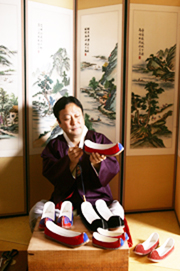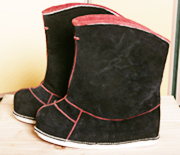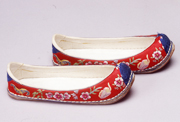There’s no business like shoe business

Master shoemaker Hwang Hae-bong puts the final touches on hye, traditional Korean shoes that the upper classes wore during the Joseon Dynasty. All photos by Kim Hyon-dong
Hwang Hae-bong has been making traditional Korean shoes, known as hwa and hye, since he was 16 years old. Today he continues the tradition in a small workshop in his apartment in Macheon-dong, southeastern Seoul.
“It is a lonely job and there were numerous times in my youth when I thought of quitting for a more active profession, one that did not require so much sitting around,” Hwang said.
Hwang’s father was also in the family business, but his grandfather outlived his father.
The shoemaker, who believes he is the last cobbler still working in his particular field, said when orders are in, he works from 9 a.m. to 6 p.m. It takes from three days to a week to complete a pair, he said.
But business is slow these days. Traditional shoes are now only worn on special occasions like weddings or a child’s first birthday.
The cost is prohibitive. A single shoe costs 500,000 won ($545). That means if a couple getting married buy traditional shoes, they need to shell out 2 million won.
Most of his business is through word-of-mouth recommendations, and his clients tend to be among the wealthier section of society. Samsung Chairman Lee Kun-hee has ordered shoes from Hwang.
Hwang’s worktable is the size of a pizza box. Around him are the simple tools of his trade: cow, pig and sheep leathers, large and small scissors, and rolls of thick string. Hwang said in the past shoemakers also used horse and deer skin for making shoes.
Hwang is a fifth-generation hye craftsman, and his 27-year-old second son is currently learning the family trade. His first son, 29, opted out and pursues another career.
His second son, a talented craftsman, has a good teacher. Hwang was designated an intangible cultural asset by the Cultural Heritage Administration in 2004. And Hwang’s grandfather was intangible cultural asset number 36, and also an expert maker of hye.
Hwang’s dad started out in the business during the ‘70s. But times were hard and it wasn’t until the ‘80s when there was a resurgence in Korean traditional items, including shoes.
Hwang started out by running errands for his grandfather. When he was discharged from the military in 1975, he decided to take up the craft full time.
“I thought to myself, ‘Somebody should keep this tradition alive,’” he said.
“It was like a destiny.”
The story of the Korean traditional shoe reflects many fascinating aspects of life in the past. The kind of shoes you wore depended on your sex, rank, social background and, above all, your income.
Hye have always been expensive, and during the Joseon Dynasty the steep price ensured that they were only worn by members of the upper classes.
“The only time a commoner could wear such shoes was on special occasions, such as at weddings,” Hwang said. This was a kind of unwritten social law that was understood by society.
“However, by the end of the Joseon Dynasty, as the social class system broke down, more people found the means to buy these shoes,” Hwang said.
“My grandfather said the shoemaking business was at its peak in those days,” Hwang said.
Hwa, also known as mokhwa, were worn by the higher social classes for official business such as going to the royal palace. They were like boots, covering the ankle and shin.
Hye were worn on more casual occasions.
The term “hye” is unfamiliar to many Koreans today. The shoe is now known by its more common name, kkotsin, which literally means “flower shoe.”
“There was a film called ‘Kkotsin’ made in 1978, so the term is better known these days,” Hwang said.

Hwa, traditional men’s shoes worn on formal occasions.
“The truth is gomusin only started to be worn in the Japanese colonial period. They were much easier to keep clean and in good condition, and they could be worn when it rains,” Hwang said.
Jipsin were worn by commoners, such as farmers.
It is not clear how far back the hye date, but they were worn during the Joseon Dynasty. At that time, a thriving community of hwa and hye craftsmen were centered in Jongno, central Seoul, where the Boshingak bell stands today.
Hye were replaced by rubber shoes in the 1920s, and later by Western shoes in the 1930s.
“There is an old Korean saying that goes, ‘Keep your head cold but your feet warm,’” Hwang said. “Our ancestors put a lot of emphasis on the health of the feet.
“Even today people put a lot of care into their shoes. Old people in particular arrange their shoes neatly after they take them off,” Hwang said.
One of the interesting features of traditional Korean shoes, Hwang noted, is that they are uniform in shape. Unlike modern Western shoes, which are curved according to the shape of the feet, Korean shoes, left and right, are shaped exactly the same. The idea is that the shoes conform to the shape of the feet after they are worn.
“After you have worn the shoes a few times, you can tell which shoe goes on which foot by the way it feels,” Hwang said.
In Korean shoemaking, Hwang said, the curvature goes in a different direction.
“Oriental craftsmanship puts a lot of emphasis on the beauty of a curve,” Hwang said.
In fact, looking at the side view of a hye, one notices that the shoe is slightly curved up at the toe, like the bow of a Viking ship.
Hwang said in the past the curve used to be more pronounced. As the shape of the modern foot has changed with time, today the curve is not as high as it used to be.
“People in the past wore a sock called a beoseon,” Hwang said. “The special character of the sock is that the tip is narrow, which gathered the toes together,” the shoemaker said.
“This helped people make curved-toed shoes more comfortable.
However, today people wear flat modern shoes and stockings, which makes the front of the foot wider and therefore makes curved-toed shoes uncomfortable.”
There are many classifications for the different kinds of traditional shoes, reflecting the rigid and precise nature of the Confucian world. It’s not surprising that there were more types of shoes for men than for women.
“Men had more ceremonial duties and jobs than women,” Hwang said. Women, being less active around town, needed fewer kinds of shoes.
The most superior type of shoe for men was called jeokseok. They were worn by kings during special rituals or ceremonies and are thought to date back to the Goryeo Dynasty.
One interesting feature is that jeokseok were red, which was unusual because blue was more commonly associated with men in that time.
The shoes also had ribbon-like silk laces tied around the ankle to keep the shoe from slipping, especially during ceremonies. A thread of twisted blue silk was also tied around the shoes for extra security.
The most common hye for men was the taesahye, a flat shoe made of silk or leather from sheep. The front tip was wide and high, and cow leather was used for the sole.
Taesahye were identified by a pattern of white lines at the tip.
Woekohye had no distinctive patterns. The cover of the shoe was made from silk dyed white, jade, black or gray, or from deer skin dyed black or gray.
Balmakhye were worn by older men who had to use a cane to walk. These shoes were either black or grey.
Yuhye, also known as jingshin, were worn in wet weather by men and women. These shoes were made waterproof using perilla oil. This oil comes from the same plant that gives us kkaenip, a strongly flavored leaf used in Korean cuisine.
The sole of the shoe was hammered down using clout nails to ensure extra protection against puddles and rain.
Baekhye were white shoes that people wore during days of national mourning following the death of the king.
Jaehye were worn during rituals and ceremonies. They look like hye except there are 3-centimeter long white ribbons which are used as shoelaces.
There are two types of hwa, also known as mokhwa: hwaja and baemokhwa.
Joseon government officials wore mokhwa as part of the formidable attire they wore on visits to the palace.
Hwaja extend over the ankle. They were black and had no decorative patterns. The sole is made of either leather or wood and a thick woolen fabric or leather makes up the ankle.
Baekmokhwa look very much like hye, but these were worn by government official during the mourning period following the death of a king.
For women, cheongseok were worn by the queen during rituals and ceremonies.
They were much the same as the king’s jeokseok, except they were blue instead of red.
Danghye were worn by women from upper-class families and were considered very precious. They were adorned with silk patterns.
Unhye were very much like danghye, except for the pattern of a cloud on the heel. The Chinese character of un means “cloud”' It was considered the most beautiful of the shoes that women wore during the Joseon Dynasty.
Soohye are now called kkotsin. The silk covering was embroidered with pictures of Japanese apricots, peonies and lotus.
Gihye, also called woekohye, were not decorated at the tip of the shoe, like men’s woekohye. These shoes were made of black leather and silk and were mostly worn by gisaeng, female entertainers to the rich and powerful.
Looking back over the history of Korean traditional shoemaking, Hwang can’t help feel a pang of regret. He said that Korean shoes could be counted among the best shoes in the world, as well-regarded as Gucci, if they had changed with the times.

Soohye, traditional decorated shoes for women.
lost what we call ‘traditional,’” Hwang said.
The shoemaker said his grandfather didn’t force him to continue the family trade. He thought it was a dying craft.
“My grandfather told me that in the past his ancestors worked for the royal family, so making a living was not a problem,” Hwang said.
“But with the introduction of modern Western shoes, many people started to shy away from old traditional shoes, which made business really difficult.”
The shoemaker said although Korean people should take pride in their traditions, it is difficult to cling to the past, especially when the world is changing so fast.
“Still if people keep searching for traditional shoes, the business will prosper and our traditions will live on,” Hwang said.
By Lee Ho-jeong Staff Writer [ojlee82@joongang.co.kr]
*Next week: Traditional confectionary










with the Korea JoongAng Daily
To write comments, please log in to one of the accounts.
Standards Board Policy (0/250자)